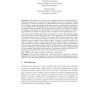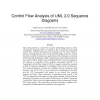230 search results - page 30 / 46 » A formal analysis of requirements-based testing |
27
Voted
FAC
2008
13 years 7 months ago
2008
Abstract. Slicing is a program analysis technique that was originally introduced to improve program debugging and understanding. The purpose of a slicing algorithm is to remove the...
ENTCS
2002
13 years 7 months ago
2002
Abstract: Alias analysis for Fortran is less complicated than for programming languages with pointers but many real Fortran programs violate the standard: a formal parameter or a c...
ISOLA
2004
Springer
14 years 26 days ago
2004
Springer
Methods for Worst-Case Execution Time (WCET) analysis have been known for some time, and recently commercial tools have emerged. However, the technique has so far not been much use...
ECMDAFA
2005
Springer
14 years 1 months ago
2005
Springer
This article presents a control flow analysis methodology based on UML 2.0 sequence diagrams (SD). In contrast to the conventional code-based control flow analysis techniques, thi...
RTSS
1999
IEEE
13 years 11 months ago
1999
IEEE
In this paper, we demonstrate a high-level approach to modeling and analyzing complex safety-critical systems through a case study in the area of air traffic management. In partic...


